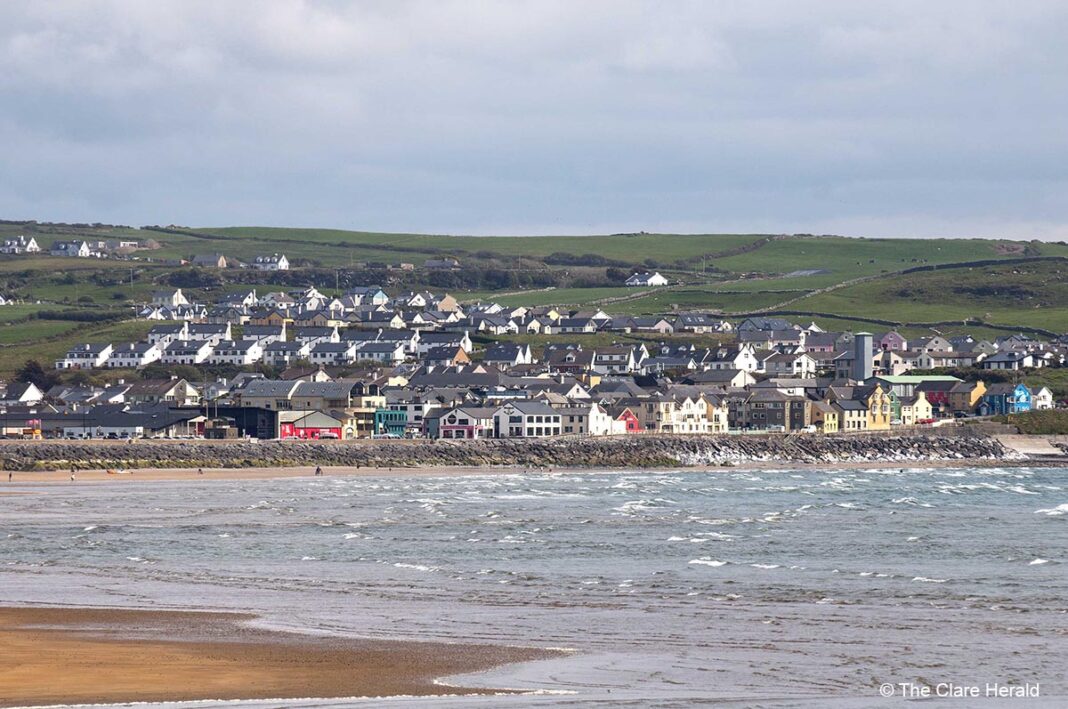The annual survey of coasts and inland waterways by business group Irish Business Against Litter (IBAL) shows Lahinch and Doolin both deemed ‘littered’, with Mountshannon also slipping, to ‘moderately littered’.
The study of 33 areas nationwide revealed our most littered areas to have cleaned up but the majority of beaches falling short of clean status, despite the unsettled summer meaning lower visitor numbers.
Beaches, harbours, rivers and their immediate environs were monitored by An Taisce in June and July. While there was a 50% rise in clean sites overall, the survey again found our coastal areas to be more littered than our towns, which IBAL researches as part of its Anti-Litter League programme.
The An Taisce report for Mountshannon stated:
“Mountshannon missed getting the top litter grade, with too many small food / alcohol related items strewn about. Recent grass cutting resulted in ‘chopped up litter’ as grass was cut before the litter was removed. The recycle facilities were freshly presented, however one unit had a crack towards the base on the right hand side. Car parking area, litter bins, visitor information notices, litter bins, life-belts, etc were freshly presented. One of the dog fouling notices along the walkway had been defaced. As well as the food related litter, the most obvious items were cigarette butts. Evidence of BBQs included burnt grass and some disposable BBQ waste.”
The An Taisce report for Doolin pier and harbour stated:
“There was a very definite litter presence at Doolin – certainly more than in the 2022 survey. Signage was very clear and legible but there didn’t appear to be any specific notices relating to littering and based on the amount of litter present, there is very much a need for same. Almost all of the litter was food related e.g. pizza boxes, plastic bottles, cans (alcohol and mineral), coffee cups, sweet papers, food utensils etc. Other items included tissue paper. The most obvious non-food items were cigarette butts – not just isolated butts but several accumulations throughout. The majority of the litter was around the perimeter of the car park and on the stoney area. The dog fouling amenity beneath the large signage was in good condition.”
The An Taisce report for Lahinch beach stated: “The main beach area at Lahinch was generally fine with regards to litter but it was the prom, rock armour and car parks which brought down the overall litter grade. The area was certainly more heavily littered than in the 2022 survey. Heavy levels of alcohol / mineral cans, fast-food wrappers, plastic bottles, plastic utensils, sweet wrappers, dog-fouling and cigarette butts, with lower levels of other items were present.
There was a variety of marine related (along with food items) litter trapped in the rock armour near the promenade e.g. fishing crates, lines / nets / ropes etc. A somewhat filled black sack was discarded by a Big Belly bin with other items accumulating on top of it. The older blue style bins look very ‘tired’ and risk the contents being extracted by birds – there didn’t appear to be any signage associated with them. This is in contrast to the freshly presented Dog Fouling facility which was in very good order. There was the remains of several fires in the grass near the top car park.”
The popular beaches at Portmarnock and Lahinch deteriorated to ‘littered’ status,as did Dog’s Bay in Galway, while those at Bundoran, Ballybunion, Skerries and Strandhill were deemed ‘moderately littered’. Clean beaches included Killiney, Salthill and Tramore, as well as Brittas Bay, which improved on last year.
“Over an unsettled summer, where our beaches attracted far fewer numbers than normal, one might have expected the majority to be virtually free of litter,” says Conor Horgan of IBAL. “Unfortunately, this does not reflect the state of our coastal environment. There is much ‘long lie’ litter and waste coming in from the sea, and this is compounded by litter from those who continue to frequent our coastline despite the inclement weather.”

Cleaning up the blackspots
For the first time since IBAL commenced its coastal surveys in 2017, no area was deemed a litter blackspot. Blackrock Castle (Cork Harbour), a blackspot in previous IBAL surveys, improved to littered, as did White Bay in Cork and the Tolka River at Annesley Bridge in Dublin. There was a positive turnaround at Grand Canal Dock in Dublin, previously ‘heavily littered’, which was judged ‘moderately littered’.
Rise of the vapes
Disposable vapes were revealed as an emerging form of litter, encountered in 1 in 7 of all visits, making them significantly more common on our beaches than on our streets.
“This time last year we were not seeing this form of litter at all, so its rapid emergence is worrying. So, too, is its impact on our environment,” warns Conor Horgan. IBAL favours the banning of disposable vapes, which, it contends, run counter to the notion of a circular economy. Vapes contain electronics, chemical waste and single-use plastic which breaks down into microparticles, endangering sea life. “At a time when we are urgently trying to reduce plastic pollution in our oceans, the emergence of vapes is concerning.” Research shows the number of disposable vapes sold each year in the US would stretch for over 7,000 miles.^
IBAL credits the Clean Coasts programme, which supports over 2,000 volunteer groups, as a major force in ridding our coasts of litter throughout the year. Its annual ‘Big Beach Clean’ takes place nationwide each September. The continued rise in volunteers, now in excess of 40,000, reflects the growing public concern around the marine environment.
